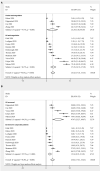Prevalence of Venous Thromboembolism in Critically Ill Patients With Coronavirus Disease 2019: A Meta-Analysis
- PMID: 33996843
- PMCID: PMC8116594
- DOI: 10.3389/fmed.2021.603558
Prevalence of Venous Thromboembolism in Critically Ill Patients With Coronavirus Disease 2019: A Meta-Analysis
Abstract
Background: Accumulating evidence suggests that coronavirus disease 2019 (COVID-19) is associated with hypercoagulative status, particularly for critically ill patients in the intensive care unit. However, the prevalence of venous thromboembolism (VTE) in these patients under routine prophylactic anticoagulation remains unknown. A meta-analysis was performed to evaluate the prevalence of VTE in these patients by pooling the results of these observational studies. Methods: Observational studies that reported the prevalence of VTE in critically ill patients with COVID-19 were identified by searching the PubMed and Embase databases. A random-effect model was used to pool the results by incorporating the potential heterogeneity. Results: A total of 19 studies with 1,599 patients were included. The pooled results revealed that the prevalence of VTE, deep venous thrombosis (DVT), and pulmonary embolism (PE) in critically ill patients with COVID-19 was 28.4% [95% confidence interval (CI): 20.0-36.8%], 25.6% (95% CI: 17.8-33.4%), and 16.4% (95% CI: 10.1-22.7%), respectively. Limited to studies, in which all patients received routine prophylactic anticoagulation, and the prevalence for VTE, DVT, and PE was 30.1% (95% CI: 19.4-40.8%), 27.2% (95% CI: 16.5-37.9%), and 18.3% (95% CI: 9.8%-26.7%), respectively. The prevalence of DVT was higher in studies with routine screening for all patients, when compared to studies with screening only in clinically suspected patients (47.5% vs. 15.1%, P < 0.001). Conclusion: Critically ill patients with COVID-19 have a high prevalence of VTE, despite the use of present routine prophylactic anticoagulation.
Keywords: coronavirus disease 2019; critically ill; meta-analysis; prevalence; venous thromboembolism.
Copyright © 2021 Wu, Liu, Cai, Zhang, Li and Fu.
Conflict of interest statement
The authors declare that the research was conducted in the absence of any commercial or financial relationships that could be construed as a potential conflict of interest.
Figures




Similar articles
-
Prevalence of Venous Thromboembolism in Critically Ill COVID-19 Patients: Systematic Review and Meta-Analysis.Front Cardiovasc Med. 2021 Jan 8;7:598846. doi: 10.3389/fcvm.2020.598846. eCollection 2020. Front Cardiovasc Med. 2021. PMID: 33585578 Free PMC article.
-
Risk of Clinically Relevant Venous Thromboembolism in Critically Ill Patients With COVID-19: A Systematic Review and Meta-Analysis.Front Med (Lausanne). 2021 Mar 9;8:647917. doi: 10.3389/fmed.2021.647917. eCollection 2021. Front Med (Lausanne). 2021. PMID: 33768106 Free PMC article.
-
COVID-19 Infection in Critically Ill Patients Carries a High Risk of Venous Thrombo-embolism.Eur J Vasc Endovasc Surg. 2021 Apr;61(4):628-634. doi: 10.1016/j.ejvs.2020.12.015. Epub 2020 Dec 23. Eur J Vasc Endovasc Surg. 2021. PMID: 33583710 Free PMC article.
-
Thrombosis and Bleeding After Implementation of an Intermediate-Dose Prophylactic Anticoagulation Protocol in ICU Patients With COVID-19: A Multicenter Screening Study.J Intensive Care Med. 2022 Apr;37(4):480-490. doi: 10.1177/08850666211051960. Epub 2021 Nov 25. J Intensive Care Med. 2022. PMID: 34821162
-
New Insights in the Occurrence of Venous Thromboembolism in Critically Ill Patients with COVID-19-A Large Postmortem and Clinical Analysis.Viruses. 2022 Apr 14;14(4):811. doi: 10.3390/v14040811. Viruses. 2022. PMID: 35458541 Free PMC article.
Cited by
-
Menstrual changes after the thrombo-prophylaxis or anticoagulants used during the COVID-19 infection.Prz Menopauzalny. 2023 Dec;22(4):179-185. doi: 10.5114/pm.2023.133594. Epub 2023 Dec 11. Prz Menopauzalny. 2023. PMID: 38239401 Free PMC article.
-
Estimating incidence of venous thromboembolism in COVID-19: Methodological considerations.Res Pract Thromb Haemost. 2022 Aug 15;6(6):e12776. doi: 10.1002/rth2.12776. eCollection 2022 Aug. Res Pract Thromb Haemost. 2022. PMID: 35992195 Free PMC article.
-
Coronavirus Disease 2019-Associated Coagulopathy.Microorganisms. 2022 Aug 2;10(8):1556. doi: 10.3390/microorganisms10081556. Microorganisms. 2022. PMID: 36013974 Free PMC article. Review.
-
Chronic Anti-Coagulation Therapy Reduced Mortality In Patients With High Cardiovascular Risk Early In COVID-19 Pandemic.Res Sq [Preprint]. 2022 Dec 29:rs.3.rs-2252262. doi: 10.21203/rs.3.rs-2252262/v2. Res Sq. 2022. Update in: Thromb J. 2023 Jan 30;21(1):14. doi: 10.1186/s12959-023-00460-z. PMID: 36415466 Free PMC article. Updated. Preprint.
-
Venous Thromboembolism and Associated Factors in Hospitalized Patients with COVID-19 at Addis Ababa COVID-19 Field Hospital, Ethiopia.Infect Drug Resist. 2024 Jan 26;17:305-317. doi: 10.2147/IDR.S449401. eCollection 2024. Infect Drug Resist. 2024. PMID: 38293313 Free PMC article.
References
Publication types
LinkOut - more resources
Full Text Sources
Other Literature Sources
Medical

